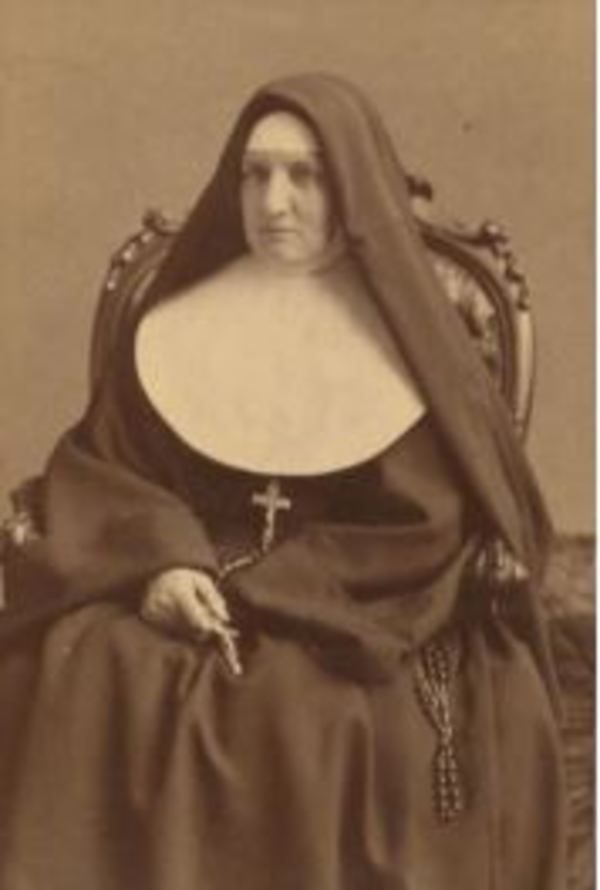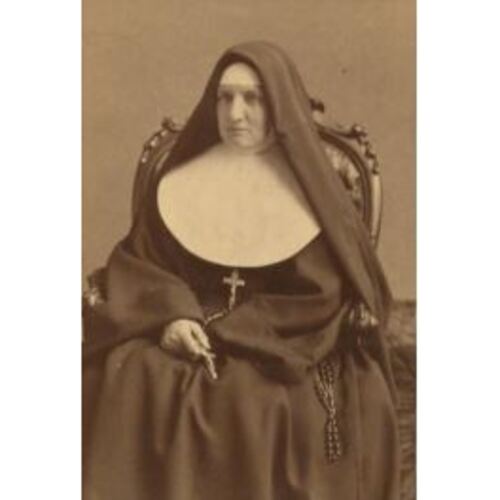
Source: Link
BRENNAN, MARGARET, named Sister Teresa, member of the Congregation of the Sisters of St Joseph; b. 1 July 1831 in Kingston, Upper Canada, second child of Michael Brennan, a merchant, and Mary Begley; d. 23 Aug. 1887 at Port Arthur (now part of Thunder Bay), Ont.
When Margaret Brennan received the religious habit of the Sisters of St Joseph in Toronto on 15 Oct. 1852, the community in Canada West had nine members, four of them the founders who had come the previous year from Carondelet (St Louis, Mo.) and Philadelphia [see Maria Bunning*]. Born into a fairly well-educated family of moderate means, she entered a poor community which cared for orphans, the indigent, and the sick. The convent was located on land donated to the diocese by John Elmsley* in a building which Mrs Elmsley and her sister Mrs John King had fitted up as an orphanage. When Margaret Brennan began her noviciate, the sisters and 55 orphans lived in this small duplex house.
In 1853 Sister Teresa began to teach at St Paul’s cathedral school, one of three institutions in which the Sisters of St Joseph taught at the time. The following year, after she had made her final profession, overcrowding at the convent necessitated the building of a noviciate and boarding-school near St Paul’s Church. The first superior general of the congregation, Marie-Antoinette Fontbonne*, named Sister Delphine, fell victim to typhus in 1856 and was replaced by Caroline Struckhoff, named Sister Teresa. Sister Teresa Brennan took over the latter’s charge as local superior of the orphanage until she was herself appointed superior general by Bishop Armand-François-Marie de Charbonnel* in 1858. The first Canadian-born member of the congregation, she now became the first Canadian-born superior general.
During the first year of her term of office Sister Teresa opened a convent and school in Oshawa. In 1862, when John Elmsley donated to the sisters two acres of his Clover Hill estate for the erection of a new motherhouse in Toronto, she supervised the planning and completion of the building, which included a boarding-school and noviciate. After five years she resigned as superior general and was appointed mistress of novices, an office which required special spiritual and intellectual qualities for the training and forming of new members. Sister Teresa also served as local superior in St Catharines (1865–66, 1869–72), in London (1868), and in Barrie (1875–78). From 1878 to 1887 she acted as assistant to the superior general, an office she had filled at various times after 1866.
Sister Teresa devoted her life with utter selflessness to the interests of the congregation, but she also had concern for those outside it. The enrolment in the Catholic schools in Toronto had steadily increased, and by 1881 the sisters were engaged in eight elementary schools. They also taught in one high school, with some financial assistance from the separate school trustees, and in their private boardingschool. In the House of Providence, opened in 1857, the orphans, the poor, the old and the young, men and women, Catholic and non-Catholic, were harboured, cared for, and even taught if they were of school age. In addition, the sick of the city were visited in their homes, although hospital work per se was not begun until St Michael’s Hospital was opened in 1892. Sister Teresa had a share in organizing and directing all these undertakings. In 1876 she even went on a fund-raising tour to the United States in order to keep the institutions running and to make it possible to have qualified sisters in the field of education.
Sister Teresa’s health was never robust. After beginning her noviciate in 1852, she became ill and was given an unheard-of permission by Bishop Charbonnel to return to her home while wearing the religious habit. Her recovery was deemed miraculous, but at times during her 35 years in religion her health obliged her to withdraw from some of her activities. Finally, in February 1887, she suffered a severe heart attack. To recuperate she went to Port Arthur, where the congregation, now 200 strong, had opened a mission in 1881. On 23 August she died suddenly, away from the motherhouse where she had spent most of her life.
Sister Teresa had amply fulfilled her mission as teacher, administrator, counsellor, and friend, and her contribution to Canada lies in the example of a life devoted to the needs of others. She also helped lay the foundation of the Sisters of St Joseph, who still carry on an apostolate in the fields of education, health care, and social work, not only in Ontario but in the western provinces and the Northwest Territories.
St Mary’s Cathedral (Kingston, Ont.), Register of baptisms, burials, and marriages, July 1831. Sisters of St Joseph of Toronto Arch. (Toronto), Reception and profession books. Sisters of St Joseph of Toronto, Community annals, [1851–1956] (3v., Toronto, [1968]), I: 6, 53, 56, 154–56. Kingston Chronicle (Kingston, [Ont.]), 2 July 1831. W. P. Bull, From Macdonell to McGuigan, the history of the growth of the Roman Catholic Church in Upper Canada (Toronto, 1939). Jubilee volume, 1842–1892: the archdiocese of Toronto and Archbishop Walsh, [ed. J. R. Teefy] (Toronto, 1892), 156. Sister Mary Agnes, The Congregation of the Sisters of St. Joseph: Le Puy, Lyons, St. Louis, Toronto (Toronto, 1951).
Cite This Article
Mary Bernita Young, “BRENNAN, MARGARET, named Sister Teresa,” in Dictionary of Canadian Biography, vol. 11, University of Toronto/Université Laval, 2003–, accessed April 24, 2025, https://www.biographi.ca/en/bio/brennan_margaret_11E.html.
The citation above shows the format for footnotes and endnotes according to the Chicago manual of style (16th edition). Information to be used in other citation formats:
| Permalink: | https://www.biographi.ca/en/bio/brennan_margaret_11E.html |
| Author of Article: | Mary Bernita Young |
| Title of Article: | BRENNAN, MARGARET, named Sister Teresa |
| Publication Name: | Dictionary of Canadian Biography, vol. 11 |
| Publisher: | University of Toronto/Université Laval |
| Year of revision: | 1982 |
| Access Date: | April 24, 2025 |



